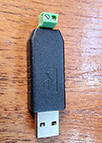The BatNav Raspberry Pi Server
The BatNav Raspberry Pi server allows you to build your own WiFi device. The Raspberry Pi is connected to your onboard instruments and acts as a WiFi hotspot that you then connect your phone/tablet to wirelessly. The downside of this is that while connected to the Raspberry Pi your device will no longer be able to access the internet.
Disclaimer. This project is provided as is. You follow these instructions at your own risk. There is no guarantee that it will work for you. This is best suited for hobbyists/enthusiasts. If you don't feel confident enough with this, it is recommended that you look at purchasing a custom built device such as those provided by Digital Yacht or Quark.
That said, let's get to work.
As well as working with the BatNav Android app, the server can be used independently with other mobile apps such as Navionics to serve both GPS and AIS information.
The total cost of building this should be around £50 to £60. To build it, you will need the following items.
- An existing GPS and/or AIS NMEA 0183 source. On my boat I used a Garmin Gpsmap 451 but any GPS with NMEA 0183 output should work. They will provide two connections, one for send and one for receive. Consult your own device's documentation if needs be. For an AIS source I used an M-TECH MT-550 radio. This model is no longer available but there are many other options. I found the advantage of using a VHF radio that also provides AIS information is that a second antenna is not required so it greatly simplifies installation. However a dedicated AIS receiver will also work as long as it has an NMEA 0183 output.
- A Raspberry Pi model 3 or higher. These cost about £35 each but it is recommended you also buy some housing for one - the housing costs about £5
- A micro SD card - at least 8gb, with appropriate computer adapter if needed as we will be flashing this from a computer. These cost about £5 each.
- A USB power source for the Raspberry Pi. I use a USB adapter connected to a cigarette lighter type connection on board. You can also get USB connections that can be wired directly to your boat's 12 volt power supply.
-

Adapter(s) to convert the NMEA 0183 signal to USB. We will need one of these for each of the GPS and/or AIS devices we are connecting. Specifically you will need an RS485 to USB adapter like the one pictured. These cost around £5 each.
The adapter should have two connections as in the one pictured. Avoid the adapters with three connections as they will not work.
-
Access to, and the skills to use a screwdriver.
